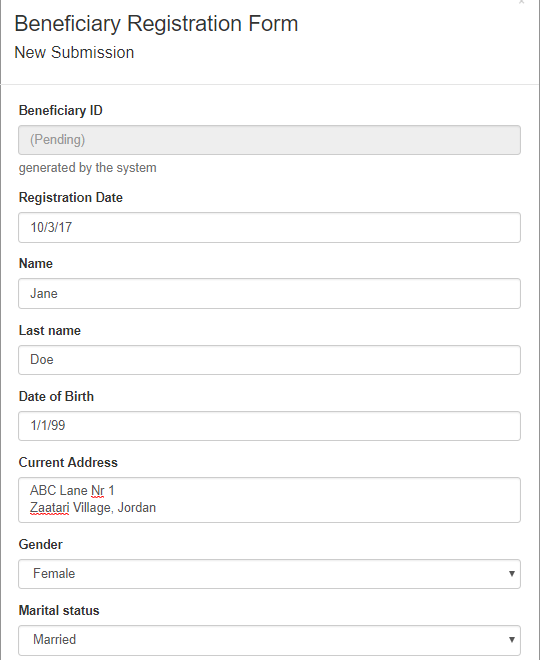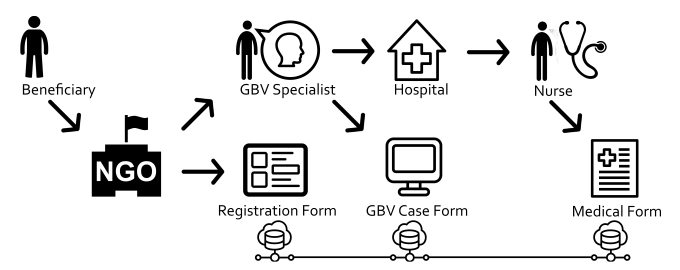Beneficiary registration with ActivityInfo
ActivityInfo has long ago passed the phase where it was only in use for tracking activity based indicators. This kind of activity tracking marked the early days of the open source web application being developed in the Democratic Republic of Congo. Nowadays, humanitarian agencies greatly value the flexibility of ActivityInfo. Indeed ActivityInfo offers agencies the ability to follow their own workflow, data needs and organisational requirements. We have written previously about examples in clusters and coordinated aid responses. Many of the new possibilities of ActivityInfo are the result of requests from various agencies. These possibilities have for example given agencies the ability to create a case management system and a beneficiary registration portal. In this blog post I will touch upon how ActivityInfo can be set up and used for beneficiary registration using anonymized examples of current roll outs.
Beneficiary registration within humanitarian settings takes place at various stages and for various purposes. Refugees register with UNHCR to obtain refugee status or with a host government to receive a Temporary Protection Identification Card. A health organisation registers refugees who are referred to their GBV program. Another examples of beneficiary registration could be the registration by WFP (World Food Program) of newly arrivals for their food program or distributions. In this blog I will elaborate on the case where an NGO works with partners in health clinics regarding GBV, Gender Based Violence. In this example the NGO provides medical and psychosocial care to GBV victims. In order to follow up on their clients the GBV case workers, doctors and team require a beneficiary registration system. I will also show that if you use some smart anonymized indicators you can also feed the information from this system into your regular organizational M&E (Monitoring and Evaluation) follow up.

Picture: UNAMID - Albert Gonzalez Farran, license: CC, source: Flickr
Registering a client or a beneficiary requires the process of collecting and storing personal data, for example the name of the beneficiary, his or her gender, marital status, number of children, but also (former) address details, ID of passport, pictures etc. Setting up a form with the ActivityInfo form designer is a simple exercise when you know all the required fields (like the examples above, name - marital status - etc).

However handling Personally-identifiable data is not without risk in humanitarian settings. A registration system has to comply with personal data protection standards. Among other things, this means that this registration data should not be accessible for those who do not need the whole data set. In most settings the workflow of beneficiary registration results into an anonymized registration ID for the beneficiary, or a barcode for example. This way data can be linked in the system, but without the aid worker having access to all the personal data. In ActivityInfo this can be implemented automatically by the use of the form field ‘serial number’.
This field generates an automated serial numbers which can be referred to in your other forms. If the ID being generated should follow a certain structure of values, this can be implemented by the functionality ‘input mask’ (click here to read the online tutorial on how to add an input mask).
When a new beneficiary approaches the NGO, the registration officer registers this beneficiary in the system. Only a few users are assigned to have access to the beneficiary registration database and forms, all according to the internal organisational protocols in place. All other employees have access to their program databases into ActivityInfo. Imagine that this beneficiary has been referred to see a protection worker. This protection officer asks the beneficiary for his/her registration number, or request this ID from the assigned registration officer within his office.

The GBV specialist has the intake and consultation with the beneficiary. The GBV specialist reports the results and consultation in the GBV Case management system setup in ActivityInfo. Furthermore the GBV specialist refers the beneficiary to the nearest health clinic for a medical check. In this medical facility the nurse will also follow up on this beneficiary using the same ID, but without having access to any of the data that (s)he has not the right to access. The nurse will also log the follow up in their health program database.

The system thus serves as:
-
- Beneficiary registration, to avoid double counting of one beneficiary in the programs for example. In this case the registered beneficiary has visited the GBV specialist and the health facility, but will be ‘counted’ as one beneficiary since these visits are linked to the same ID number.
- 2.Case management system, specialist can follow up on their beneficiaries throughout their programs, as well as in between facilities.
- 3.Provides a protected environment for personally-identifiable data.
Finally, before using ActivityInfo for beneficiary registration the M&E officer of the NGO used to request data from each department on a monthly basis. However by using ActivityInfo, several key indicators are linked (anonymously) into the M&E database. This way the M&E officer can generate automated reports on the number of new beneficiaries who have arrived in their programs, on a breakdown in gender and age, or on any other important information that used to be reported separately. By using the anonymized data directly from ActivityInfo it facilitates the NGO with a simple and accessible system, as well as reduces the burden of reporting from case workers and health workers.
Final Note on Personally-identifiable data in the humanitarian context
Personally-identifiable data is central to organisations working to deliver essential aid to vulnerable individuals. However the collection and processing of this data with technology (as ActivityInfo) has created a demand for data protection guidelines that organisations can apply in their work. The ICRC and the Brussels Privacy Hub have launched this summer (2017) a Handbook aimed at the staff of humanitarian organisations involved in processing personal data as part of humanitarian operations. Their handbook is a recommended read for anybody who is involved in humanitarian registration systems.
Data protection is of a fundamental importance for humanitarian organisations. Safety and security of data are the cornerstones of the design of the ActivityInfo system. We often receive questions regarding data responsibility, safety and security; if you wish to know more feel free to reach out to us.